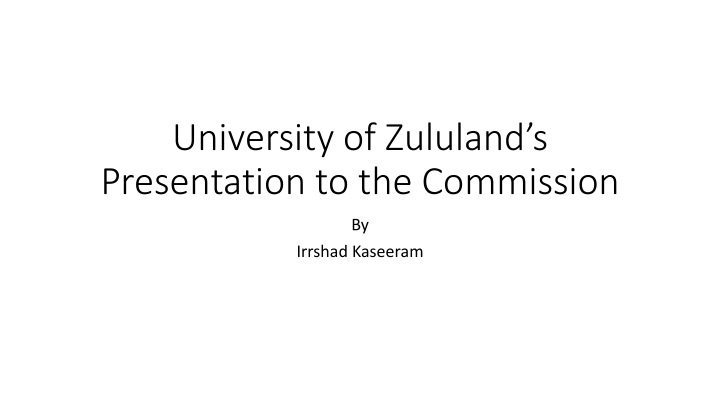



University of Zululand’s Presentation to the Commission By Irrshad Kaseeram
“The Doors of Learning and Culture shall be open to all” Freedom Charter 1952 "Everyone has a right to higher education which the state, through reasonable measures, must make progressively available and accessible.“ SA Constitution Education is a privilege and not a right A Conservative Cliché
Education is a public good that benefits all stakeholders in society from individual graduates to their families, the sectors who employ them and society in general from human capital appreciation and through economic impact and other positive externalities, hence the principle of cost sharing is reasonable one Paraphrased from Tilak (2004) UNESCO
The National Development Plan’s vision for 2030 is a tertiary education system that produces highly skilled graduates to meet the current and future needs of the economy and society. The plan stresses the need for the different components of the education system to function together in a coordinated fashion to produce the desired outcomes.
Background t to t the F e Fee ees C Crises • State made significant advances in making HE accessible to disadvantaged • NSFAS & its Predecessors (1991-2014) issued > R50 Billion to 1.5 Million students – State being faithful to its transformation agenda • Since 1994 student numbers more than doubled • Although state increased spending but due to increasing numbers spending per student fell by about 33% currently compared to 1997. • 2003 to 2015 State increased the NSFAS loan component to students 6% to 28%
• Rising cost of tertiary education and lower net government support, higher loan burden exacerbated unaffordability for poor and middle-income households; • Students from Household with mean Income > R122 000 pa, do not qualify for NSFAS are severely financially constrained… the "missing middle"; • The high drop-out rate from tertiary institutions that particularly affects students from poor households; • High graduate unemployment especially those from historically disadvantaged universities prevents NSFAS debt clearance; and • NSFAS challenges, including ineffective administration, under-skilled staffing and poor loan recovery.
Princip iple le o of C Cost S Sha harin ing • Education = Public Good - all of society benefits hence costs must be shared between main stakeholders • Cost sharing through fees, philanthropic private contributions, taxation and other innovations (SIBs) is necessary • Holistic approach is needed to develop an subsidized funding model targeting affected students through building strong interrelationships between government, tertiary institutions and the private sector
Tertiary Institutions Public Private Partnerships • Sustainable TIPPPs : synergies gained through effective coordination of programmes can solve problems at multilayers • Philanthropic inclinations/Corporate Social responsibilities could be BEE linked or other tax incentives • Unlock sufficient funding targeted to needy students sustainably. • Coordination of recruitment needs/graduate placement/in service training/ obligatory service for a negotiated period • Holistic development planning for a brighter future involving all stake holders
Cost S Sharing: S Student C Contribution o on a Sliding S Scale • Students from indigent and middle income households should not pay fees upfront • however loans:subsidy ratio should be apportioned to them on a sliding scale in direct proportion the household income. • Loans payable once they start earning incomes above a certain threshold level. • More affluent students above a certain threshold (say above R500 000 pa) ought to be charged higher fees on a sliding scale. • Savings from cost-sharing can be used for broadening access to tertiary education through strengthened student support systems. • Allow institutions to differentiate tuition fees across courses to make systems more responsive to student and employer preferences and generate efficiency gains ie. Charge lower fees for courses and programmes that are in high demand in the market place relative to those which are not.
Stude udent C Contribut bution o n on a Slidi ding ng S Scale • Loan repayment ends once loan is freed • Tax employed graduates on a sliding scale (say 1% tax for top 5% of graduate earners and a sliding scale for lower income earners) • Such an ongoing tax could: * ensure funding for successive waves of students and * could assist in other funding mechanisms (SIBs)
Socia ial I l Impact B Bonds ( (SIBs) • Social Investment = Repayable Finance to achieve a social and a financial return • SIBs are innovative instruments to finance social programmes combined with market discipline • First introduced in 2010 in the UK since then increasing number of countries have used it • Ideal vehicle for TIs to fund infrastructural investment • South Africa is ideally positioned to adopt a variation of SIBs: • Regulation 28 Pension Funds and SOEs encouraged to seek out socially and environmentally effective investments and to publish results of such investments • Possible to expand Regulation 28 to include Banks, Insurers and other Investment houses • Added incentives could be tax breaks (including exemption from Capital Gains Tax!) • Underwritten by Government drawing on funds from graduate taxes and TI contributions
Effec ective M e Managem emen ent S System ems • TIPPPs well designed partnership; effective regulatory framework and commitment from state to enforce four way contracts with students, TI and PS • Developing centralised database of student including academic records, household income to allocate loan to subsidy ratios • Social contracts with students inclusive of psychosocial, life skills, and academic support to ensure graduate attributes the market values • Quality Assurance and relevance of TI programmes to labour market • Block Grants to TIs, based on transparent formulae, involving a balanced array of input and output indicators. • SIBs Funding allocations to TI based on performance agreements with government and private sector
Thank You Ngiyabonga
Recommend
More recommend